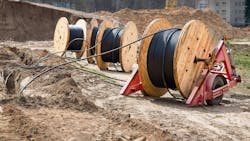PG&E Announces Plan to Underground 10,000 Miles of Power Lines in Highest Fire-Threat Areas
Pacific Gas and Electric Co. (PG&E) recently announced a major initiative to expand the undergrounding of electric distribution power lines in High Fire-Threat Districts (HFTD) to further harden its system and help prevent wildfires.
The new infrastructure safety initiative, announced in Butte County by PG&E Corp. CEO Patti Poppe, is a multi-year effort to underground approximately 10,000 miles of power lines. It represents the largest effort in the United States to underground power lines as a wildfire risk reduction measure.
"We want what all of our customers want: a safe and resilient energy system. We have taken a stand that catastrophic wildfires shall stop. We will partner with the best and the brightest to bring that stand to life. We will demand excellence of ourselves. We will gladly partner with policymakers and state and local leaders to map a path we can all believe in," Poppe said.
In addition to significantly reducing wildfire risk, undergrounding also benefits customers by lessening the need for Public Safety Power Shutoffs (PSPS), which are called as a last resort during dry, windy conditions to reduce the risk of vegetation contacting live power lines and sparking a wildfire. Undergrounding also eases the need for vegetation management efforts, leaving more of California's trees untouched.
Today, the PG&E maintains more than 25,000 miles of overhead distribution power lines in the highest fire-threat areas (Tier 2, Tier 3, and Zone 1) — which is more than 30% of its total distribution overhead system.
10,000 miles of PG&E lines represent approximately the distance of 11 round trips from Chico to Los Angeles or almost halfway around the world. The exact number of projects or miles undergrounded each year through the PG&E's new expanded undergrounding program will evolve as the PG&E performs further project scoping and inspections, estimating and engineering review.
Public Engagement
The PG&E will engage customers and stakeholders as it develops a plan and reviews potential additional undergrounding sites based on a variety of factors, including local municipal planning and safety considerations. Engineering an underground electric system requires designing the system around existing water, natural gas, and drainage systems, as well as planning for future road widening. The PG&E intends to work closely with customers and local, state, federal, tribal, and regulatory officials throughout this new safety initiative.
Learning from Projects
In the past, undergrounding has been done on a select, case-by-case basis and largely for reasons other than wildfire risk reduction. Thanks to the breakthroughs the PG&E has achieved on undergrounding projects in recent years, undergrounding can now play a much more prominent role in the PG&E's ongoing efforts to harden the electric grid.
Following the devastating October 2017 Northern California wildfires and the 2018 Camp Fire, the PG&E began to evaluate placing overhead power lines underground as a wildfire safety measure, and to better understand the construction and cost requirements associated with undergrounding for system hardening purposes. These demonstration projects were part of the PG&E's Community Wildfire Safety Program (CWSP) and included the following:
- From 2018 to 2020, the PG&E completed multiple demonstration projects aimed at converting overhead power lines to underground in high fire-threat areas of Alameda, Contra Costa, Nevada, and Sonoma counties.
- As a part of the rebuild efforts following the October 2017 Northern California wildfires, the PG&E completed undergrounding 8 miles of power lines in the Larkfield Estates and Mark West Estates communities in Sonoma County in 2018.
- In 2019, the PG&E announced it would rebuild all its power lines underground in the Town of Paradise as it helps the community recover from the Camp Fire. The company is also rebuilding power lines underground within the 2020 North Complex Fire footprint in Butte County.
Through these demonstration projects and rebuild efforts, the PG&E has been able to refine the construction and cost requirements associated with targeted undergrounding, enabling the acceleration and expansion of undergrounding projects. Learnings include:
- Implementing new planning systems and strategies and using new materials and new equipment to make undergrounding more cost-effective.
- Building strong partnerships with material suppliers and contractors to accelerate undergrounding efforts.
- Partnering with natural gas projects as well as phone and internet providers to joint trench and share costs, where possible.
- Using new technology and construction methods to increase trench production.
- Bundling work into larger blocks to take advantage of economies of scale.
- Testing new cable and conduit materials to accelerate undergrounding work processes.
Ongoing Wildfire Mitigation, Resilience Efforts
In addition to expanding its undergrounding, the PG&E's ongoing safety work to enhance grid resilience and address the growing threat of severe weather and wildfires continues on a risk-based and data-driven basis, as outlined in the utility's 2021 Wildfire Mitigation Plan (WMP).
This includes:
- Installing stronger poles and covered power lines.
- Deploying remote grids and community microgrids.
- Targeted sectionalizing and grid reconfiguration.
- Investing in centralized data analytics to reduce risk.
- Conducting enhanced vegetation management.
- Scaling the deployment of emerging technologies to proactively mitigate wildfire risk.
To learn more about the PG&E's wildfire safety efforts, visit here. A recording of the recent announcement is available on the PG&E's YouTube channel.
